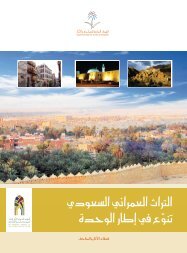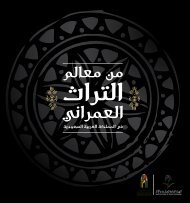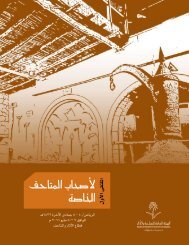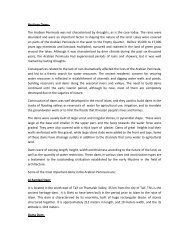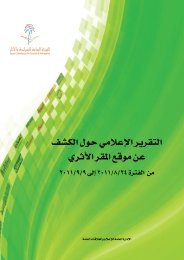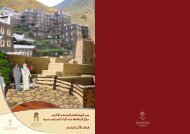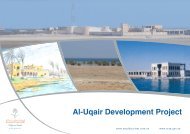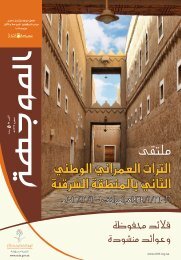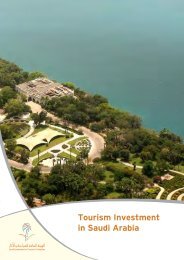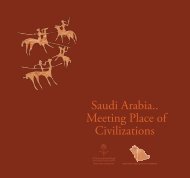Roads of Arabia
Roads of Arabia
Roads of Arabia
You also want an ePaper? Increase the reach of your titles
YUMPU automatically turns print PDFs into web optimized ePapers that Google loves.
17 Arabie US p286-307.qxd 23/06/10 22:02 Page 296<br />
ROADS OF ARABIA<br />
Hegra <strong>of</strong> <strong>Arabia</strong> Felix<br />
several chambers, which may have been executed within the same architectural programme <strong>of</strong><br />
the tomb façade and chamber, most <strong>of</strong> the graves were executed according to need. Therefore<br />
in principle for each burial the tomb had to be reopened and a grave cut to the dimensions <strong>of</strong><br />
the defunct.<br />
Fig. 10. Nabataean inscription (Jaussen and Savignac no. 12)<br />
engraved inside a cartouche with double dovetails on the<br />
façade <strong>of</strong> tomb IGN 29<br />
“This is the tomb which Wushuh, daughter <strong>of</strong> Bagrat, and<br />
Qaynu and Nashkuyah, her daughters, Taymanites, made for<br />
themselves, for each one <strong>of</strong> them, and for ‘Amirat and<br />
‘Usra’nat and ‘Al-alat, their sisters, daughters <strong>of</strong> this Wushuh,<br />
and for everyone under their protection, male or female, in<br />
order for Wushuh and her daughters mentioned above, and all<br />
<strong>of</strong> their protégés to be buried in this tomb. And it behoves<br />
Wushuh and her daughters and all <strong>of</strong> their protégés, male or<br />
female, not to sell and not to pawn and not to alter anything<br />
in this tomb for anyone. And whoever alters the above shall<br />
owe one hundred Aretas drachmae to Ta{dha}y and the same<br />
amount to our lord Aretas. In the month <strong>of</strong> Iyyar, year 43 <strong>of</strong><br />
Aretas, king <strong>of</strong> the Nabataeans, who loves his people. Done by<br />
Halp’allahi, the stonecutter.”<br />
The systematic sketches <strong>of</strong> all the tombs have highlighted two stages <strong>of</strong> occupation <strong>of</strong><br />
the Hegra massifs. A first ancient stage features burial chambers vertically cut out in the<br />
rock walls, their interior entirely filled with pit-graves. The second stage features the<br />
Nabataean façade tombs described above. The excavations in 2008 in one <strong>of</strong> the tombs<br />
probably belonging to the first stage, IGN 125 (Jaussen and Savignac no. C4) unfortunately<br />
did not enable dating. The excavations begun in 2008 and continued in 2009 inside one<br />
<strong>of</strong> the rare Nabataean tombs that had not been entirely cleaned produced more results. 15<br />
This small tomb, IGN 117 (Jaussen and Savignac no. C14), with two rows <strong>of</strong> merlons (fig.<br />
5) is dated to 61 AD by the inscription engraved on its façade. The excavation, not yet completed,<br />
yielded a great amount <strong>of</strong> wood (probably elements <strong>of</strong> c<strong>of</strong>fins), as well as leather and<br />
fabrics that wrapped the deceased. Several periods <strong>of</strong> occupation were revealed, all Pre-<br />
Islamic; the oldest being that <strong>of</strong> the tomb owner. Above all, the anthropological study <strong>of</strong> the<br />
bones indicated the presence <strong>of</strong> a minimum <strong>of</strong> sixty-four individuals, including thirty-eight<br />
adults (thirteen men, thirteen women, twelve <strong>of</strong> undetermined gender), their stature varying<br />
between 1.45 metre to 1.71 metres and twenty-six juveniles aged between zero and nineteen<br />
years. Young children, up to four years old, are less represented: this demographic category<br />
may have been given a separate burial treatment. In addition, the study <strong>of</strong> discrete<br />
characters – non-pathological anatomical variations directly observable on the skeleton –<br />
revealed the existence <strong>of</strong> blood ties between the individuals buried in the tomb. Several<br />
pathologies, in particular on the vertebrae but also fractures, were also observed.<br />
Of course religion was present in Hegra. Contrary to Petra however, where the space<br />
devoted to religious practices is organized in a markedly hierarchical manner and religious<br />
monuments (temples, holy places, banquet halls, small rock sanctuaries) are found in all the<br />
sectors <strong>of</strong> the antique site, the cultic space <strong>of</strong> Hegra, as far as we now know it, is mostly concentrated<br />
in an area <strong>of</strong> the site named Jabal Ithlib. This crag rising in the north-east <strong>of</strong> the<br />
site is the highest and the most uneven, presenting the sharpest summits. Vestiges <strong>of</strong> monumental<br />
architecture, notably elements <strong>of</strong> columns, have actually been found intra-muros<br />
and on the edge <strong>of</strong> the city on the slopes descending gradually towards it from the east. But<br />
the monuments to which these elements belong have not been identified and the city temple<br />
where the city archives were kept, as some inscriptions on the tombs indicate, has yet to<br />
be found. Aside from Jabal Ithlib and its southern outskirts, Hegra yielded very few religious<br />
monuments. At the most a few baetyls (sacred stones) associated with tombs, several<br />
baetyl niches cut out in the outcrops rising inside the city, and also a few niches carved in<br />
different places <strong>of</strong> the site and which do not seem related to any other vestige.<br />
15. Directed by I. Sachet, archaeologist, and<br />
N. Delhopital, anthropologist; see Delhopital<br />
and Sachet, in Nehmé, Al-Talhi and Villeneuve<br />
2009 [2010], pp. 205–58.<br />
The interior <strong>of</strong> Jabal Ithlib, accessible by a narrow gorge which recalls in miniature the<br />
famous Siq in Petra, is cut in two by a wadi hemmed in by two rocky banks, the slopes <strong>of</strong><br />
which are sometimes broken by projecting ledges (fig. 12). The most well-known monument<br />
<strong>of</strong> this sector, hewn at the entrance <strong>of</strong> the gorge, is a large banquet hall with three<br />
benches, a triclinium, called the Diwan (fig. 13), where the Nabataean religious confraternities<br />
gathered in groups <strong>of</strong> thirteen persons, including two musicians. A large number <strong>of</strong><br />
Fig. 11. Burial chamber in tomb IGN 9<br />
It contains the three types <strong>of</strong> burial structures found in the Hegra tombs:<br />
numerous niches and caissons, as well as a trench<br />
in the floor <strong>of</strong> the chamber (in the centre <strong>of</strong> the photo)<br />
296<br />
297



